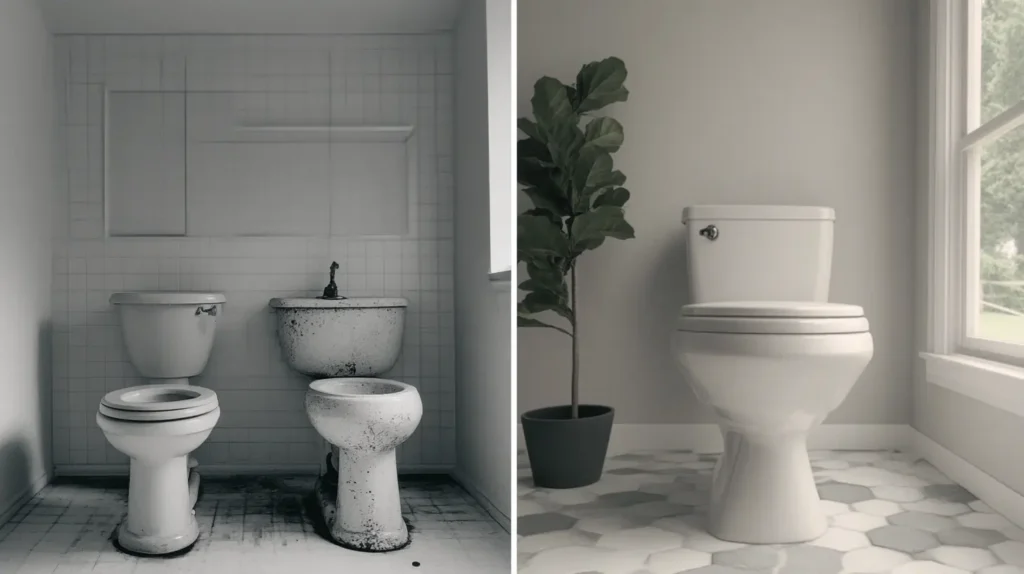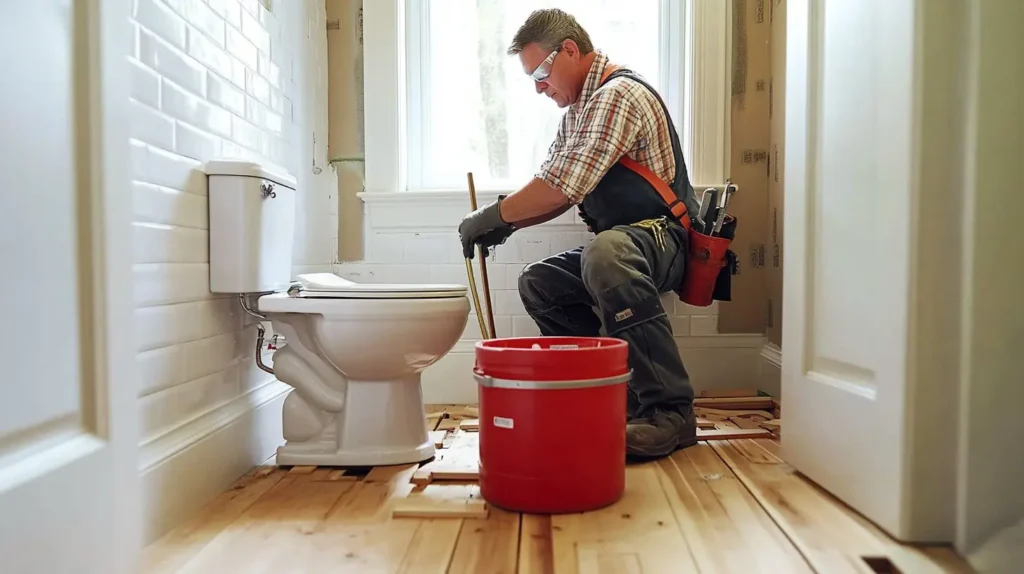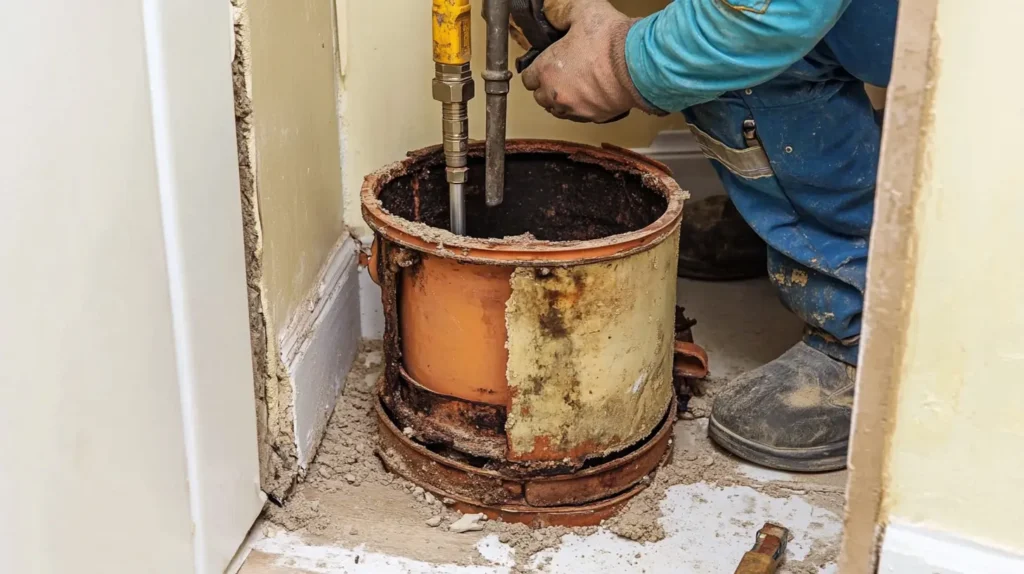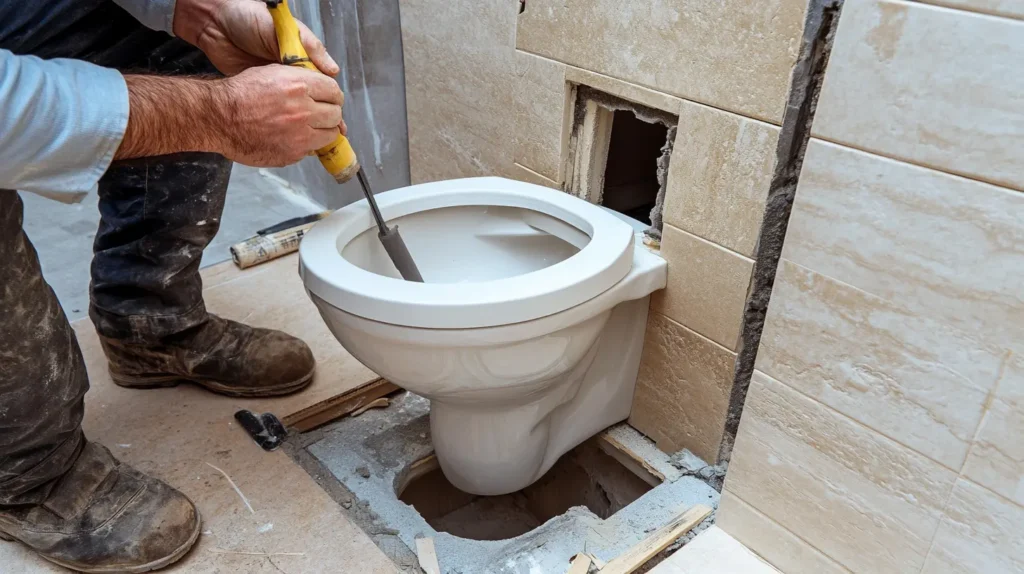Introduction
If you’ve ever experienced the sinking feeling of flushing your toilet only to have it refuse to cooperate—whether it’s making odd noises, leaking, or failing to flush with gusto—you’re not alone. Toilets are one of the hardest-working fixtures in any Northeast Florida home, from Jacksonville to St. Augustine and all the charming towns in between. But, like all household features, they don’t last forever. Eventually, you might find yourself asking, “Is it time for a toilet replacement?”
Here at Kingdom Based Plumbing, we’ve been installing, repairing, and replacing toilets across St. John’s County for years. Over that time, we’ve seen just about every possible plumbing scenario—ranging from routine fixes like toilet seat replacement or toilet handle replacement, all the way to diagnosing major issues that demand a full-scale toilet replacement. Whether you live in a historic home in the heart of St. Augustine or a newer residence in Jacksonville, our guide will help you figure out when it’s time to say goodbye to your old throne and welcome in a shiny new one.
In this article, we’ll break down the telltale signs your toilet is past its prime, what to do about common plumbing problems, and how to decide if a replacement is right for you. We’ll also share essential tips on local regulations, brand recommendations (like Kohler toilet replacement), and the solutions we offer as your friendly neighborhood plumbers. Let’s dive in!
Section 1: Signs Your Toilet Is Past Its Prime
No homeowner wants to rush out and purchase a brand-new toilet when a simpler repair might solve the problem. Yet, there are times when a toilet has simply reached the end of its lifespan and continuing to patch it up becomes more hassle than it’s worth. Below, we’ll take a deeper look at some of the most common indicators that your toilet may be due for retirement—and why investing in a replacement could save you from repeated headaches down the line.

Constant Clogging
It’s one thing to experience a clog every now and then—perhaps when someone gets a little too enthusiastic with the toilet paper. However, if your toilet is clogging more frequently and you find yourself reaching for the plunger on a weekly or even daily basis, something more serious may be going on. Over time, the inner channels of a toilet can develop mineral deposits that constrict water flow, especially in older models. Likewise, mechanisms like the trapway or flush valve can wear out, losing the efficiency they once had. While a clogged toilet can often be fixed with a plunger or snake, recurrent blockages are a sign your “old faithful” may no longer be up to modern standards.
Cracks in the Porcelain
Porcelain is surprisingly durable, but it’s not invincible. Small hairline cracks can form due to age, impact, or even fluctuating temperatures. These cracks might seem insignificant at first glance, but they can lead to persistent leaks and, in the worst cases, full-fledged water damage around the base of the toilet. If you step into the bathroom and notice a bit of pooling water—especially around the day’s end, after you’ve been away—hairline cracks could be the culprit. Although some minor cracks can be sealed as a temporary measure, major fractures almost always call for a replacement. In coastal regions like Jacksonville or St. Augustine, humidity and salt in the air can further exacerbate porcelain deterioration, making it crucial to tackle cracks quickly.
Excessive Age and Wear
Even if your toilet is free of leaks and still flushes, an older model can be a silent burden on your water bill. Modern toilets must adhere to federal efficiency standards of 1.6 gallons per flush or less, whereas older units may use upwards of three to five gallons each time. Over months and years, that extra water usage adds up significantly, both in cost and environmental impact. Additionally, older toilets can be more prone to internal part failures, like worn-out fill valves and corroded bolts, meaning you’ll likely spend more time and money on maintenance. Upgrading to a newer design not only lends a fresh look to your bathroom but can also substantially lower your monthly utility expenses.
Frequent Repairs
If you feel like you’re on a first-name basis with your plunger, or if you’ve already handled multiple toilet seat replacement or replace toilet fill valve jobs this year alone, it might be time to throw in the towel. Constantly fixing leaks, fiddling with the flush handle, or needing to replace toilet flange parts can become an endless cycle. While each individual fix might be minor, the cumulative cost and aggravation can far exceed the price of purchasing and installing a new, more reliable fixture. A new toilet can provide peace of mind, reduce your overall plumbing bills, and eliminate the stress of wondering what will break next.
Taking the Next Step
If any (or all) of these issues sound familiar, it’s likely time to explore your toilet replacement options. Whether you live in a historic home in St. Augustine with an old-fashioned plumbing system or a newer property in Jacksonville facing unexpected wear and tear, replacing your outdated commode could be the smartest move. In the following sections of this guide, we’ll discuss the financial and functional benefits of a toilet upgrade and outline how to choose the right model for your Northeast Florida home.
Section 2: The Cost and Benefits of Toilet Replacement
Replacing a toilet can feel overwhelming, whether you’re thinking about the financial outlay or the logistics of removing and installing a new fixture. However, when weighed against the advantages of an updated and more efficient toilet, the decision often becomes clearer. Below, we’ll examine the primary benefits of upgrading to a newer model and why the investment can pay off in multiple ways—especially for homeowners and businesses here in Northeast Florida.

Improved Efficiency
One of the most compelling reasons to upgrade an older toilet is water conservation. If your current fixture dates back a few decades, it might be flushing two or even three times as much water as modern, low-flow models. Because older toilets can use anywhere from three to five gallons per flush, households in Jacksonville or St. Augustine with a high frequency of bathroom visits could be wasting thousands of gallons of water each year. In contrast, today’s toilets must meet federal standards of 1.6 gallons per flush or less, with many newer models using even less while maintaining excellent flushing power. This reduction in water use doesn’t just help the environment—it also lowers your monthly utility bill. For businesses in St. John’s County, where restrooms see heavy foot traffic, the water savings can be especially significant over time.
Updated Aesthetics and Comfort
Toilets now come in a staggering array of styles, shapes, and finishes, allowing you to choose a fixture that perfectly complements your bathroom’s décor. From sleek, modern silhouettes with minimalistic lines to more traditional designs that align with a classic aesthetic, there’s a model out there for every preference. Height is another aspect to consider; “comfort-height” toilets or ADA-compliant models sit a few inches higher than standard ones, making them easier on the knees and back. This added comfort can be a game-changer for older adults, people with mobility challenges, or anyone who simply wants a more ergonomic design. If you’ve been eyeing amenities like a bidet attachment, heated seat, or built-in night light, upgrading is the perfect opportunity to incorporate these features—all of which can significantly enhance the daily experience of using your bathroom.
Reduced Need for Repairs
An outdated toilet often demands more attention than you might realize. Maybe it’s a toilet handle replacement here, or you need to replace toilet fill valve parts there—before you know it, you’ve put more money into a single fixture than the cost of purchasing a new unit. Worn-out hardware, inefficient flush mechanisms, and constantly running water can all contribute to mounting repair bills. Moreover, older toilets are susceptible to leaks around the base, which may force you to replace toilet flange or even address water damage if left unchecked. Upgrading to a contemporary model—particularly from reputable brands like Kohler, American Standard, or Toto—can drastically reduce these ongoing maintenance costs. New toilets often come with robust warranties and feature improved engineering, ensuring better reliability and peace of mind for years to come.
Potential Value for Your Home
While a toilet may not be the first feature that comes to mind when considering a property’s resale value, it can still have an impact. Homebuyers tend to look for signs that a property has been well maintained and updated to current standards. A new, water-efficient toilet suggests that the homeowner has kept up with essential improvements—often giving potential buyers confidence in the condition of the home’s overall plumbing. Plus, an attractive, modern bathroom fixture can simply make a property more appealing during walkthroughs or showings. If you’re on the fence about selling your home soon, upgrading the toilet now still lets you enjoy its benefits, while also providing a bonus selling point when the time comes.
Ultimately, the cost of a new toilet—along with professional installation, if you choose that route—can be a wise investment in both your short-term comfort and long-term savings. The next step is to identify common toilet problems that might still be solvable with simpler repairs. By understanding those solutions, you’ll be better prepared to decide whether a full replacement is the most practical path forward.
Section 3: Common Toilet Problems and Their Solutions
It’s easy to assume you need a brand-new toilet the moment something goes awry, but that isn’t always the case. In many instances, a more targeted repair will address your immediate problem and help you avoid the expense and hassle of a full toilet replacement. Below, we’ll delve into some of the most common issues you may encounter—and offer guidance on when they’re indicative of a larger problem versus a straightforward fix.

Leaking or Running Toilet
Few things are more frustrating than the sound of constantly running water, especially if it’s accompanied by an ever-increasing water bill. Often, the culprit is a deteriorating flapper—a small rubber component that seals the flush valve opening. Over time, the flapper can harden or warp, preventing a secure seal and causing water to continuously trickle from the tank into the bowl. In such cases, a toilet flapper replacement usually resolves the issue quickly. However, if the leak persists or you notice corrosion around other internal parts, you may need to replace toilet fill valve components as well. High mineral content in Northeast Florida’s water supply can accelerate wear and tear on these parts. If you’re replacing multiple components one after another, it might be more economical to consider a newer, more efficient toilet.
Weak or Incomplete Flush
Flushing multiple times just to clear the bowl wastes water and can be embarrassing, particularly if you have guests. Sometimes, the solution is as simple as adjusting the water level in your toilet tank or cleaning the rim jets around the bowl to ensure water flows freely. In other scenarios, the problem could stem from a clogged siphon jet—a small opening near the base of the bowl designed to help force waste down the drain. Blockages can form from mineral deposits or paper buildup, reducing flushing power. If you discover these components are too worn or damaged to repair, a partial component replacement (like installing a new flush valve) can often restore functionality. However, if the internal mechanisms are extensively corroded or you’re dealing with an older toilet that’s no longer up to modern efficiency standards, it might be time to weigh the benefits of a new fixture.
Unusual Noises
Strange sounds coming from your toilet can feel like you’re living in a haunted house. A high-pitched whistling or hissing noise often indicates a faulty fill valve that struggles to regulate water entering the tank. A fill valve replacement tends to be a simple fix, requiring only basic tools and some attention to detail. Meanwhile, a loud “banging” noise known as water hammer may occur when the water supply abruptly stops, causing a shockwave in the pipes. Installing water hammer arrestors or adding air chambers can mitigate this jarring sound. In older homes throughout St. Augustine and the surrounding areas, outdated plumbing systems might require a professional assessment to ensure stability and reduce the likelihood of further pipe damage.
Toilet Handle or Seat Problems
Broken handles and cracked seats may not be catastrophic issues, but they can still be inconvenient. A toilet handle replacement is usually a quick DIY project—simply remove the old handle, insert a new one through the handle mounting hole, and secure it with the provided hardware. For a toilet seat replacement, there’s an array of design options available, from padded seats to soft-close lids that save you from startling noises in the middle of the night. When browsing your local hardware store in Jacksonville or St. John’s County, you’ll find handles in various finishes—chrome, brass, or even nickel—so you can match them to your bathroom’s existing fixtures.
Issues with the Toilet Flange
A stable toilet relies on a robust connection between the bowl and the waste pipe. The toilet flange facilitates this connection, forming a seal that prevents leakage and ensures the toilet remains firmly anchored to the floor. Over time, the flange can corrode or crack, especially in environments with high humidity or where moisture accumulates around the toilet’s base. While some homeowners might attempt a replace toilet flange job themselves, complications can arise if the subfloor is damaged or if the existing flange is difficult to access. In these cases, it’s best to consult a professional plumber who can evaluate the condition of both the flange and the surrounding flooring, ensuring you don’t end up with hidden water damage or mold.
When Do Minor Issues Signal a Bigger Problem?
If you find yourself replacing one part after another—handles, fill valves, flappers—yet still fighting recurrent leaks or incomplete flushes, that’s often a sign the fixture is nearing the end of its life cycle. In the next section, we’ll guide you through determining whether a repair is still viable or if a full toilet replacement makes more sense for your budget and peace of mind.
Section 4: When to Repair vs. Replace
Deciding whether to fix your existing toilet or invest in a brand-new one can be more challenging than it seems. Sometimes, a quick repair is all you need to restore a toilet to proper working order. In other cases, you might find that frequent breakdowns, obsolete parts, or significant structural problems make replacing the entire fixture the wiser long-term choice. Below, we’ll explore the key factors that help determine which route is right for you.
Signs a Repair Might Suffice
- Repairs are Affordable and Simple
If you discover that something as minor as a toilet handle replacement or a quick swap of the flush valve parts brings your toilet back to life, there’s a good chance you don’t need to replace the entire unit. For example, if you’re dealing with an occasional leak caused by a worn flapper, installing a new flapper can be a cost-effective fix. Likewise, if a weak flush is improved by cleaning mineral buildup around the rim jets or adjusting the float in the tank, you can often keep your current toilet running smoothly with minimal expense. - The Toilet is Still Relatively New
If your toilet is under a decade old, there’s a strong possibility it meets modern water-efficiency standards (1.6 gallons per flush or less). Furthermore, newer toilets are often constructed with replaceable components that are easy to find at local hardware stores in Jacksonville or online. By addressing minor issues—like a slow leak or the need to replace toilet fill valve parts—you can extend the life of your fixture for years without resorting to a brand-new installation.
When a Replacement Makes More Sense
- Multiple or Recurring Issues
If you’ve had to repair the same toilet multiple times within a short span—whether it’s swapping out the fill valve, adjusting the flush mechanism, or handling leaks at the base—you’re probably dealing with more than just normal wear and tear. Constant maintenance can become an exhausting (and costly) cycle. At a certain point, installing a new toilet saves you both time and frustration. - Obsolete or Hard-to-Find Parts
Some older toilets were designed with components that are no longer widely manufactured. While you may be able to track down discontinued parts, they can be prohibitively expensive or unreliable. If you can’t easily find what you need for a decent price, a more modern fixture—be it a Kohler toilet replacement or an American Standard model—might be the better choice. Not only do newer toilets boast improved engineering and water efficiency, but their parts are also readily available. - Structural Damage or Cracks
Cracked porcelain is a major concern. Even a small fracture can lead to leaks that damage your floors or subflooring. If you notice water pooling around the base, or if you see visible cracks in the tank or bowl, it’s often a sign that the unit’s structural integrity is compromised. These issues can grow more severe over time, increasing your risk of a sudden and messy flood. In such cases, it’s typically best to replace the toilet entirely rather than risk further damage.
Moving Forward
By weighing the complexity and cost of repairs against the likelihood of future problems, you can make a well-informed decision about your toilet’s future. Sometimes, a basic repair will keep your toilet performing reliably for years to come. Other times—especially when you’re contending with multiple issues, outdated parts, or serious damage—upgrading to a new fixture can save you stress and money in the long run. In the next section, we’ll discuss some of the most trusted brands on the market and what to expect during the Kohler toilet replacement process.n, let’s check out some recommended brands and what you should know about the Kohler toilet replacement process.
Section 5: Best Practices for Toilet Replacement
Deciding to replace your toilet is a significant step, but ensuring the process goes smoothly requires careful planning and consideration. Whether you’re upgrading for efficiency, aesthetics, or functionality, adhering to best practices can help you select the perfect model for your Northeast Florida home and avoid common pitfalls. Here are some essential guidelines to follow when undertaking a toilet replacement project.

Choosing the Right Brand
Selecting a reputable brand is crucial for ensuring longevity, performance, and satisfaction with your new toilet. Among the top contenders are Kohler, Toto, and American Standard, each offering a diverse range of models to suit various preferences and budgets.
- Kohler Toilet Replacement
Kohler is renowned for its durability, innovative features, and stylish designs. Many Kohler models boast enhanced flush power, which not only improves performance but also reduces water usage. Features like easy-to-clean surfaces and quiet-close lids add to the overall user experience, making Kohler a favorite among homeowners seeking both functionality and elegance. - Toto
Toto has established itself as a leader in high-tech bathroom fixtures. The introduction of the Washlet revolutionized the market, and Toto continues to push boundaries with features such as heated seats, integrated bidet functions, and advanced flushing systems. For those who appreciate cutting-edge technology and superior comfort, Toto offers a range of options that blend seamlessly with modern bathroom aesthetics. - American Standard
A trusted name in plumbing fixtures, American Standard provides a wide array of toilet models that balance efficiency and style. Their toilets are designed to meet stringent water-saving standards without compromising on performance. With models available at various price points, American Standard caters to both budget-conscious homeowners and those looking for premium features.
Measure Twice, Install Once
Accurate measurements are fundamental to a successful toilet replacement. Before purchasing a new unit, measure the “rough-in” distance—the distance from the wall behind the toilet to the center of the floor drain. While most modern toilets have a standard 12-inch rough-in, older homes in areas like St. Augustine or Jacksonville may feature 10- or 14-inch rough-ins. Ensuring the correct rough-in measurement prevents installation issues and additional costs.
Additionally, consider the shape of the toilet bowl. Round bowls are more compact and suitable for smaller bathrooms, while elongated bowls offer extra comfort and a more spacious feel. Assessing your bathroom’s layout and your personal comfort preferences will help you choose the most appropriate bowl shape for your space.
Check Your Local Codes
Florida’s plumbing codes are designed to ensure safe and efficient installations, but local regulations can vary. It’s essential to verify any specific requirements related to water usage, installation methods, or fixture standards in your area. Some municipalities may offer rebate programs or incentives for installing WaterSense-labeled toilets, which meet strict efficiency guidelines and can lead to significant savings on your water bill. Consulting with a local plumber or your municipality’s building department can provide clarity on these regulations and available incentives.
Professional vs. DIY Installation
While a toilet installation might seem manageable as a DIY project, especially for those with some plumbing experience, there are hidden complexities that can lead to costly mistakes. Improper installation can result in leaks, damage to the flange, or an improperly sealed wax ring, leading to water damage and increased repair costs. Here’s why opting for professional installation can be beneficial:
- Expertise and Experience: Professional plumbers have the skills and knowledge to handle unexpected challenges, ensuring a secure and efficient installation.
- Time and Convenience: Hiring a professional saves you time and the hassle of troubleshooting installation issues.
- Warranty Protection: Many toilet manufacturers require professional installation to maintain warranty coverage. Ensuring your installation is handled by experts can protect your investment.
At Kingdom Based Plumbing, we manage the entire replacement process, from removing your old fixture to ensuring a flawless new installation. Our expertise guarantees that your new toilet functions perfectly and integrates seamlessly with your existing plumbing system.
Consider the Extras
A toilet replacement is an excellent opportunity to incorporate additional features that enhance comfort and functionality. Consider the following upgrades:
- Bidet Attachments: Adding a bidet can improve hygiene and reduce the need for toilet paper, making it an eco-friendly choice.
- Soft-Close Seats: Prevent noisy slams and extend the life of your toilet seat with soft-close models.
- Advanced Flush Systems: Some models offer dual-flush options, allowing you to choose between a full flush for solid waste and a partial flush for liquid waste, further conserving water.
- Heated Seats and Night Lights: Enhance your bathroom experience with heated seats for added comfort and built-in night lights for better visibility in low-light conditions.
Additionally, take this opportunity to inspect and replace any aging plumbing parts, such as the toilet flange, to ensure a tight seal and prevent future leaks. Addressing these components during the replacement process can save you from potential headaches down the road.
Moving Forward
By following these best practices, you can ensure a successful toilet replacement that meets your needs and enhances your bathroom’s functionality and appearance. From selecting the right brand and accurate measurements to understanding local codes and deciding between professional and DIY installation, each step plays a crucial role in achieving a smooth and effective upgrade. In the next section, we’ll explore how enlisting local, professional help can make your toilet replacement process completely hassle-free.
Conclusion
Your toilet is a daily necessity, so deciding whether to repair or replace it is no small matter. From signs of aging porcelain to rising water bills, there are plenty of clues telling you when a toilet replacement might be the best route. If you’re in Jacksonville, St. Augustine, or anywhere in St. John’s County, a new, efficient model could improve not only your plumbing but also your monthly utility costs and home’s overall comfort.
At Kingdom Based Plumbing, we pride ourselves on helping our Northeast Florida neighbors find the most practical, cost-effective solutions, whether that means replacing a toilet flange, upgrading an older fixture with modern parts, or recommending the best toilet replacement for your home. Ready to reclaim your throne? Give us a call—we’re here to help!
Frequently Asked Questions
Below, we’ve answered some of the most common questions about toilet replacements and repairs. Feel free to reach out to us directly if you have more specific concerns!
1. How to replace a toilet?
Answer:
Replacing a toilet generally involves the following steps:
- Turn off the Water Supply: Shut off the valve behind the toilet, then flush to drain as much water as possible. Use a sponge or a shop vac to remove leftover water in the tank or bowl.
- Disconnect and Remove the Old Toilet: Unscrew the water supply line from the tank. Then remove the nuts that hold the toilet to the floor. Rock the toilet gently to break the wax seal and lift it away.
- Clean the Flange: Scrape off any old wax from the flange. Inspect the flange for damage—if it’s cracked or corroded, you may need to replace the toilet flange.
- Position the New Wax Ring: Place a new wax ring on the flange or on the toilet outlet, depending on preference.
- Set the New Toilet: Carefully lower the new toilet onto the flange, ensuring the bolts come through the mounting holes. Press down gently to form a tight seal.
- Tighten Bolts and Reconnect Water: Hand-tighten the bolts, alternating sides to keep the toilet level. Reconnect the water supply line, turn the water back on, and do a test flush.
If you encounter wobbling or difficulty with the seal, don’t hesitate to call a professional. Improper installation could lead to leaks or water damage.
2. How to replace toilet flapper?
Answer:
The flapper controls how much water is released when you flush. To replace it:
- Turn off the Water: Shut off the valve behind the toilet and flush to empty most of the water from the tank.
- Remove the Old Flapper: Unhook or unclip the flapper from the overflow tube and remove the chain from the flush lever.
- Install the New Flapper: Clip the new flapper onto the overflow tube and connect the chain to the flush lever. Make sure there’s a slight slack in the chain, but not too much.
- Test the Flush: Turn the water back on and flush a few times to confirm the flapper seals properly.
3. How to replace toilet fill valve?
Answer:
A faulty fill valve can cause a running toilet or weak flush. Here’s how to replace it:
- Shut Off and Drain: Turn off the water supply and flush the toilet to drain the tank.
- Remove the Old Fill Valve: Disconnect the water supply line from the bottom of the tank. Remove the mounting nut holding the fill valve in place.
- Install the New Valve: Insert the new fill valve according to the manufacturer’s instructions. Adjust the height if necessary. Secure it with the mounting nut and reconnect the supply line.
- Test and Adjust: Turn on the water. Adjust the float level to ensure the water stops at the correct height. Flush to confirm the tank refills properly, and check for any leaks.
4. How to replace toilet seat?
Answer:
Swapping out an old seat can give your toilet a fresh look and feel:
- Remove the Old Seat: Flip up the covers on the seat bolts (at the back of the seat) and use a screwdriver or wrench to loosen them.
- Clean the Rim: Once the old seat is off, clean any debris around the bolt holes.
- Attach the New Seat: Position the new seat’s hinges over the bolt holes. Insert the bolts and tighten the nuts from below.
- Check Alignment: Align the seat so it’s centered. If it’s off, loosen the bolts slightly, adjust, and retighten.
5. How much does it cost to replace a toilet?
Answer:
The cost varies depending on factors like the toilet model, local labor rates, and any additional repairs needed (for instance, if you need to replace toilet flange or handle underlying plumbing issues).
At Kingdom Based Plumbing, we provide accurate, upfront quotes so you’ll know exactly what you’re getting into. Whether it’s a simple seat swap or a full installation, our goal is to ensure you have a sturdy, efficient toilet that suits your budget and style.



